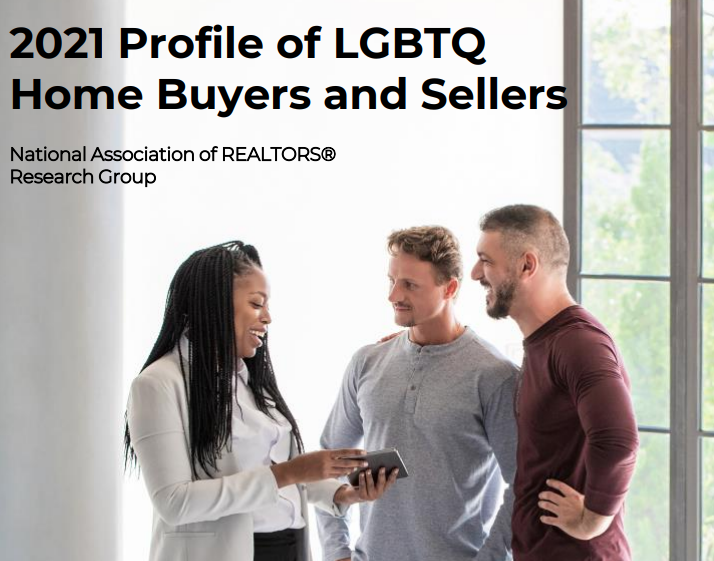
Key Highlights
- LGBTQ buyers purchased older and smaller homes than non-LGBTQ buyers, and expect to live in their new homes five years less than non-LGBTQ buyers.
- LGBTQ buyers and sellers were more likely than non-LGBTQ to be single men and unmarried couples and were more likely to identify as male than as female.
- Bisexual buyers and sellers were more likely than other groups to be younger, be first-time home buyers or sellers and report lower incomes.
WASHINGTON (June 9, 2021) – Home buyers from America’s LGBTQ community purchase older, smaller and less expensive homes than non-LGBTQ buyers, according to the 2021 Profile of LGBTQ Home Buyers and Sellers released today by the National Association of Realtors®. Over the past 5 years, homes bought by LGBTQ buyers were 170 square feet smaller and 15 years older, typically, than those purchased by non-LGBTQ buyers.
“Understanding how buyers navigate the housing market is essential to Realtors®,” said Jessica Lautz, NAR’s vice president of demographics and behavioral insights. “This report details the impact of the housing affordability challenges on LGBTQ buyers, who typically had lower household incomes and were more likely to be purchasing more affordable homes.” NAR first added a question about sexual orientation to its annual Profile of Home Buyers and Sellers study in 2015.
Characteristics of Homes Bought/Sold
NAR’s annual report also found that the median sale price for homes purchased by LGBTQ buyers was $245,000, compared to $268,000 for non-LGBTQ buyers. LGBTQ buyers were much more likely to have purchased in urban areas and less likely to have bought in small towns or rural areas. All groups were equally likely to have purchased in a suburb or subdivision.
LGBTQ buyers expected to spend 10 years in their new home, five years fewer than non-LGBTQ buyers. While there were no significant differences between the groups when it came to home types purchased, comparing LGBTQ home sellers to non-LGBTQ home sellers showed that LGBTQ sellers were less likely to sell a detached single-family home (69% vs. 81%) and more likely to sell a townhouse/row house (11% vs 6%) or an apartment condo (8% vs 4%).
Characteristics of Buyers and Sellers
Since 2015, the percentage of LGBTQ home buyers and sellers has remained steady at 4%, with 51% identifying as male and 40% identifying as female. Eight percent identified as non-binary, gender-nonconforming, or third gender.
Married couples made up 39% of LGBTQ buyers and sellers, while 21% of transactions were completed by an unmarried couple, 22% by a single male and 15% by a single female. The median age (42) and annual income ($93,200) of LGBTQ buyers and sellers were slightly lower than non-LGBTQ buyers and sellers (46 and $97,000, respectively).
Forty-two percent of LGBTQ buyers were first-time home buyers, compared to just 32% for non-LGBTQ buyers. However, the two groups were about equally likely to be first-time home sellers – at 37% and 33%, respectively.
When further examining the demographics and buying habits within the LGBTQ community, notable differences were seen between Lesbian/Gay buyers and sellers and Bisexual buyers and sellers. The typical bisexual home buyer and seller was 34 years old compared to 45 among buyers and sellers identifying as gay or lesbian. Sixty-three percent of bisexual buyers and sellers were female. They were more likely to report single-income households than other home buyers, even when controlling for age. Bisexual home buyers were also much more likely to be first-time home buyers (61%) or first-time home sellers (50%) than other groups.
Considerations in Home Search
When considering locations for buying a home, the three most important qualities – quality of neighborhood, convenience to job and overall affordability – were the same for all groups. LGBTQ buyers were less concerned overall about convenience to friends and family compared to non-LGBTQ buyers. They also placed more importance on convenience to entertainment and leisure and proximity to a veterinarian. Additionally, LGBTQ buyers were less likely to value proximity to and quality of schools, convenience to health facilities and lot sizes than other Americans.
“All Realtors® are obligated by NAR’s Code of Ethics to provide equal professional service without discrimination based on sexual orientation or gender identity,” said NAR President Charlie Oppler, a Realtor® from Franklin Lakes, N.J., and the CEO of Prominent Properties Sotheby's International Realty. “As we recognize Pride Month and Homeownership Month this June, it’s important to continue the pursuit of equal housing opportunities for everyone. Our communities are stronger when we are more inclusive.”
Survey Methodology
The data used for this report is an aggregation of all of the responses from those who specified sexual orientation from the 2015 through 2020 NAR Profile of Home Buyers and Sellers survey, totaling 41,950 responses. Just over four percent of all respondents in the survey – 1,574 total individuals – identified as LGBTQ. For more information on NAR’s 2021 Profile of LGBTQ Home Buyers and Sellers visit https://www.nar.realtor/research-and-statistics/research-reports/profile-of-lgbtq-home-buyers-and-sellers.
The National Association of Realtors® is America’s largest trade association, representing more than 1.4 million members involved in all aspects of the residential and commercial real estate industries.
Source: "NAR Report Finds LGBTQ Buyers Purchasing Older, Smaller Homes Than Other Americans"











Comments